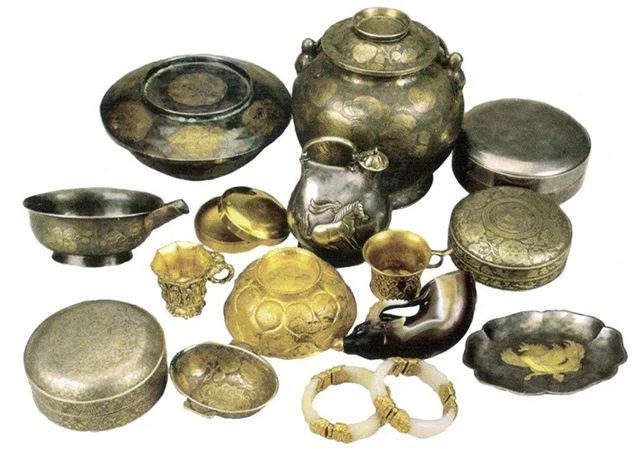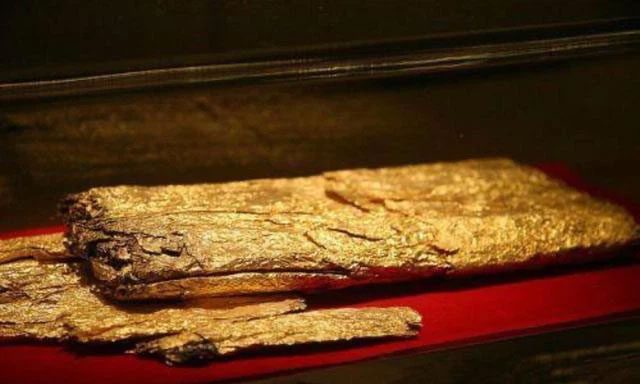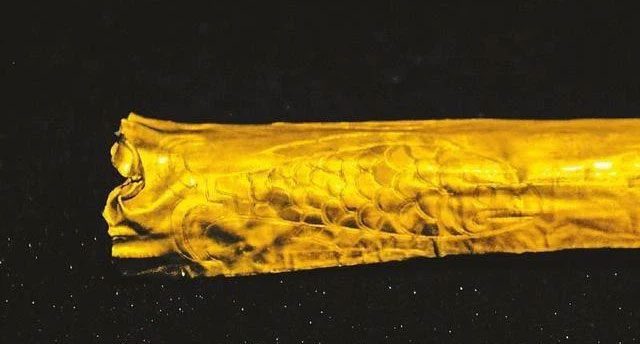On October 5, 1970, workers at a construction site in the southern suburbs of Xi’an, Shaanxi Province, China, unexpectedly discovered a large ceramic jar buried under less than 1 meter of soil. Digging deeper, they realized there were up to 15 or 16 other jars beneath it, all filled with dazzling gold items.
The site manager immediately reported the incident to the authorities, prompting a team from the Shaanxi Provincial Museum to rush to the scene. After a preliminary excavation, experts found a total of over 1,000 artifacts made of gold and silver, including bowls, basins, and decorative items…

Funerary items discovered in the tomb. (Photo: Sohu).
Many unique artifacts were discovered for the first time in ancient burial sites, notably four extremely valuable gold leaves. When discovered, these gold pieces were submerged in water.
Experts carefully extracted them, cleaned them, and weighed them. The total weight of the four gold leaves was precisely 5.5 kg.
With the technology available over 1,000 years ago, the goldsmiths skillfully crafted such thin gold leaves. The gold funerary items in this tomb are also noted for their remarkable quantity and incredible variety.
1kg of Gold Disappears
In January 1971, just six months after the excavation of the tomb in Shaanxi, the archaeological team reweighed the cultural relics they had found for reporting purposes.
When they placed the four gold leaves on the scale, expert Han Wei – a member of the archaeological team, could not believe his eyes: The total weight was only 4.5 kg, meaning 1 kg of gold had vanished. Han Wei immediately reported this to the museum’s management, but no one could explain it.
Four months later, when museum staff reported to store the four gold pieces, they discovered that they had lost another 0.5 kg, leaving only 4 kg. Thus, since the excavation, 1.5 kg of gold had “vanished without a trace.”

The four gold leaves continuously lost weight in a puzzling manner. (Photo: Sohu).
The management of the Shaanxi Provincial Museum immediately invited the police to investigate the incident. Initially, they suspected that someone had used advanced technology to steal the gold, with the prime suspect being expert Han Wei. Han Wei had the most contact with the gold pieces and was the first to report the weight loss.
At this point, Han Wei’s colleagues suddenly recalled an important detail that could exonerate him: when the gold was discovered, it was soaked in water: Could it be that six months later, the water had evaporated, making the gold lighter?

It turns out there are special reasons behind the theory of gold absorbing water. (Photo: Sohu).
This hypothesis was initially deemed too unreasonable. Gold is a very stable metal; sulfuric acid (H₂SO₄) or nitric acid (HNO₃) does not affect it, so how could gold absorb water?
To resolve this question, the investigation team invited two professors from the Chemistry and Physics departments of Northwest University (Shaanxi) to conduct an on-site experiment: the experts dipped the four gold leaves in water, and after a week, they removed them, cleaned off the water, and weighed them again.
The results left everyone stunned once again: the weight of the four gold leaves was 5.5 kg! At this point, they realized that the gold pieces had indeed absorbed water, and as the water evaporated over time, the weight decreased.
The truth is that the gold leaves, crafted by ancient artisans, contain many tiny holes that can only be observed under a microscope. When submerged in water for over 1,000 years, these tiny holes absorbed water, making the gold heavier than its actual weight. This special experiment helped exonerate archaeologist Han Wei and opened the eyes of future generations.





















































